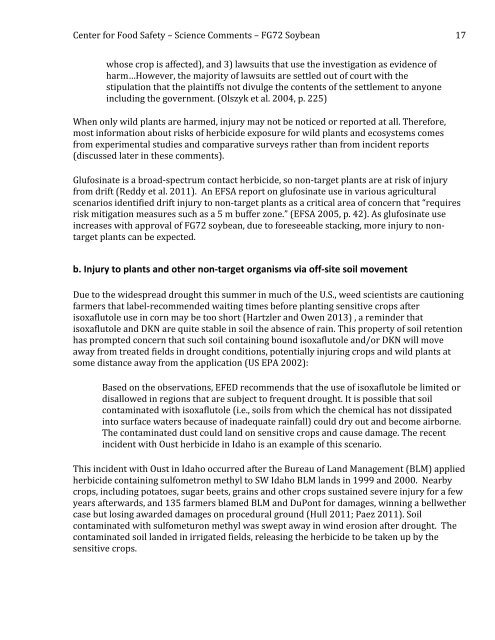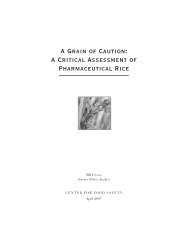a four-fold rise - Center for Food Safety
a four-fold rise - Center for Food Safety
a four-fold rise - Center for Food Safety
You also want an ePaper? Increase the reach of your titles
YUMPU automatically turns print PDFs into web optimized ePapers that Google loves.
<strong>Center</strong> <strong>for</strong> <strong>Food</strong> <strong>Safety</strong> – Science Comments – FG72 Soybean <br />
17 <br />
whose crop is affected), and 3) lawsuits that use the investigation as evidence of <br />
harm…However, the majority of lawsuits are settled out of court with the <br />
stipulation that the plaintiffs not divulge the contents of the settlement to anyone <br />
including the government. (Olszyk et al. 2004, p. 225) <br />
When only wild plants are harmed, injury may not be noticed or reported at all. There<strong>for</strong>e, <br />
most in<strong>for</strong>mation about risks of herbicide exposure <strong>for</strong> wild plants and ecosystems comes <br />
from experimental studies and comparative surveys rather than from incident reports <br />
(discussed later in these comments). <br />
Glufosinate is a broad-‐spectrum contact herbicide, so non-‐target plants are at risk of injury <br />
from drift (Reddy et al. 2011). An EFSA report on glufosinate use in various agricultural <br />
scenarios identified drift injury to non-‐target plants as a critical area of concern that “requires <br />
risk mitigation measures such as a 5 m buffer zone.” (EFSA 2005, p. 42). As glufosinate use <br />
increases with approval of FG72 soybean, due to <strong>for</strong>eseeable stacking, more injury to non-target<br />
plants can be expected. <br />
b. Injury to plants and other non-‐target organisms via off-‐site soil movement <br />
Due to the widespread drought this summer in much of the U.S., weed scientists are cautioning <br />
farmers that label-‐recommended waiting times be<strong>for</strong>e planting sensitive crops after <br />
isoxaflutole use in corn may be too short (Hartzler and Owen 2013) , a reminder that <br />
isoxaflutole and DKN are quite stable in soil the absence of rain. This property of soil retention <br />
has prompted concern that such soil containing bound isoxaflutole and/or DKN will move <br />
away from treated fields in drought conditions, potentially injuring crops and wild plants at <br />
some distance away from the application (US EPA 2002): <br />
Based on the observations, EFED recommends that the use of isoxaflutole be limited or <br />
disallowed in regions that are subject to frequent drought. It is possible that soil <br />
contaminated with isoxaflutole (i.e., soils from which the chemical has not dissipated <br />
into surface waters because of inadequate rainfall) could dry out and become airborne. <br />
The contaminated dust could land on sensitive crops and cause damage. The recent <br />
incident with Oust herbicide in Idaho is an example of this scenario. <br />
This incident with Oust in Idaho occurred after the Bureau of Land Management (BLM) applied <br />
herbicide containing sulfometron methyl to SW Idaho BLM lands in 1999 and 2000. Nearby <br />
crops, including potatoes, sugar beets, grains and other crops sustained severe injury <strong>for</strong> a few <br />
years afterwards, and 135 farmers blamed BLM and DuPont <strong>for</strong> damages, winning a bellwether <br />
case but losing awarded damages on procedural ground (Hull 2011; Paez 2011). Soil <br />
contaminated with sulfometuron methyl was swept away in wind erosion after drought. The <br />
contaminated soil landed in irrigated fields, releasing the herbicide to be taken up by the <br />
sensitive crops.







